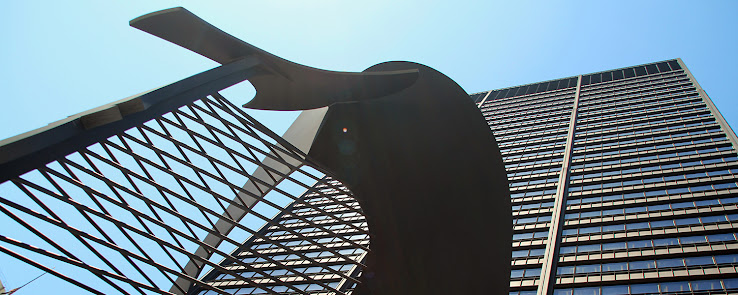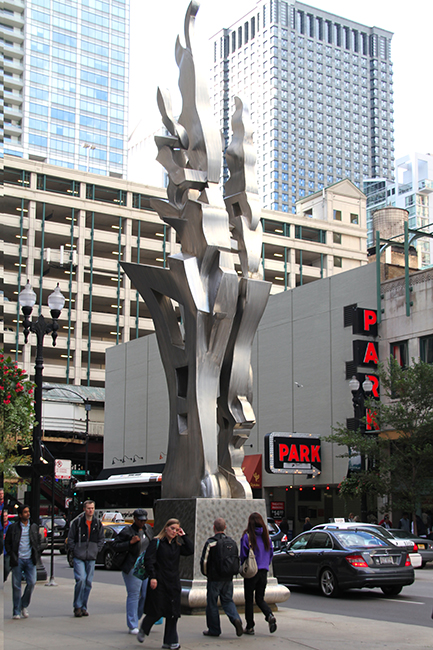Mark Di Suvero is one of America's most influential artists, famous for his massive works in abstract expressionism. On the stand seen in the third image is written ...
"He encourages viewers to walk through, on and around his sculpture, so they can experience it from all perspective"...
Temporary Exhibit: From April 17, 2007 -to- April 1, 2008.
Five sculptures of Mark Di Suvero are exhibited in the Millennium Park.
Two in the North Boeing Gallery, and..
Three in the South Boeing Gallery
NORTH GALLERY: Orion and Johnny Appleseed..
SOUTH GALLERY: Shang, Rust Angel and Yoga..
NORTH GALLERY..

Orion
2007 .. H-53' X W-26'8" X D-20' [Painted Steel]
Mark di Suvero transforms heavy industrial materials into vibrant uplifting forms. Di Suvero often paints his sculptures to bright orange red so they create a striking drawing against the blue sky. The artist draws inspiration from many sources including mathematics, physics, music, poetry and astronomy. The sculpture refers to the constellation named for the famed hunter of Greek mythology.

Johnny Appleseed.
1989-93 ... H-23' X W-22' X D-44' [Steel and Stainless Steel]
Mark di Suvero is recognized by contemporary art scholars and critics for inventing a radical style of art which challenges the very nature and defiunition of sculpture. Built from steel and found materials such as wooden beams and scrap metal, this abstract assemblages are large in scale and powerfully expressive. Open forms that unfolds and thrust outwards, his sculpture define and describe the space they occupy.
Johnny Appleseed is a masterpiece of artists use of unorthodox materials. The tiles refers to the celebrated nurseryman who redefined the American landscape by planting orchards and giving seeds and trees to pioneer settlers, introducing the apple to Ohio, indiana and Illinois ...
 SOUTH GALLERY..
SOUTH GALLERY..
Shang: 1985 .. H 25' X W 19' X D 7'8" [Steel]
The sculpture features a suspended steel I-beam bent by the artist into a swing that visitors are invited to ride. It's title refers to the Shang dynasty and is a tribute to the country where di Suvero was born ...

Rust Angel: 1995 .. H-8'11" X W-14'7" X D-7'8" [Painted Steel]
The main body of the sculpture is crafted from a single plate of steel, which Di Suvero cut with a torch, and then pulled into complex configuration.

Yoga: 1991 ...H-29' X W-31' X D-31' [Steel and Stainless Steel]
A bent steel I-beam rests high overhead on a bearing that enables it to move in the wind. the five-ton element appears weightless as it spins and rocks gently up and down.

An excerpt from the stand ... "Mark di Suvero does not make technical drawings or models from his large scale work. He engages directly with the material making the sculptures himself. He draws free hand onto steel plates which he considers his paper and the arcs he cuts out with a cutting torch express the compass reach of his outstreatched arms. Using a crane he brings steel plates and beams together welding and bolting them into place. He would also cold bend the steel with an anchor and a crane, a technique that can be seen in Rust Angel, Shang and Yoga."
These sculptures are on display ...
From April 17, 2007 - to - April 1, 2008.



















































